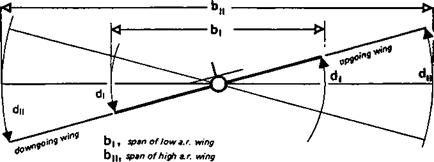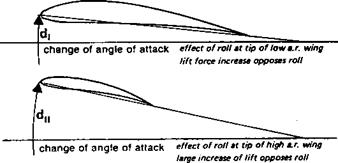ASPECT RATIO AND ROLL RATES
In addition high a. r. models are inherently slow in roll. This is partly because of the mass of the long wing, which opposes any force tending to inititate a roll, and, once the roll has begun, resists any force tending to stop iL More important, however, is the effect of aerodynamic damping. In a roll, the down-going wing experiences an increase in angle of attack, and the up-going wing a decrease. This applies only during the rolling movement (Figure 5.9). When the roll has settled to a steady rate, inertial resistance disappears, but the downgoing wing has a higher angle of attack and the up-going surface has a lower angle of attack. This generates lift forces opposed to the roll. To keep the roll going, a
|
|
|
Fig. 5.9 Aerodynamic damping of roll A large span wing tends to damp any rolling movement more than a short span, hence to achieve satisfactory rate of roll a high aspect ratio wing requires more effective controls |
powerful force against the aerodynamic damping must be provided, usually by ailerons. The long span of a high aspect ratio wing compels the outer panels of the wing to move through larger arcs for a given rate of roll. This creates larger damping forces. Accordingly the force to keep the roll going must be greater. Either larger ailerons are required, or they must be moved to larger angles, or other controls such as spoilers, etc., may be used to reinforce aileron effects. Many model sailplanes are controlled in roll entirely by the secondary effect of the rudder. As the aspect ratio rises this method becomes less satisfactory because the rudder is relatively ineffective in overcoming the rolling inertia and less efficient in countering wing aerodynamic damping. On the other hand, once a high a. r. wing has achieved a desired angle of bank it resists all forces tending to roll it out of the resulting turn, so such models may be steady in circling flight A further difficulty results from the increase of speed of the outer wing tip during a turn, with a corresponding slow speed on the inner wing. This causes the lift force on the tips to change in a manner tending to steepen the angle of bank. Control of man-powered aircraft with spans over 100 ft has proved very difficult partly because of this effect In full-sized sailplanes it is normally necessary to ‘hold off bank in turns, by applying aileron against the turn direction. Model sailplanes require the same type of control. To maintain a steady rate of turn in a thermal a little aileron trim against the turn may be needed.















